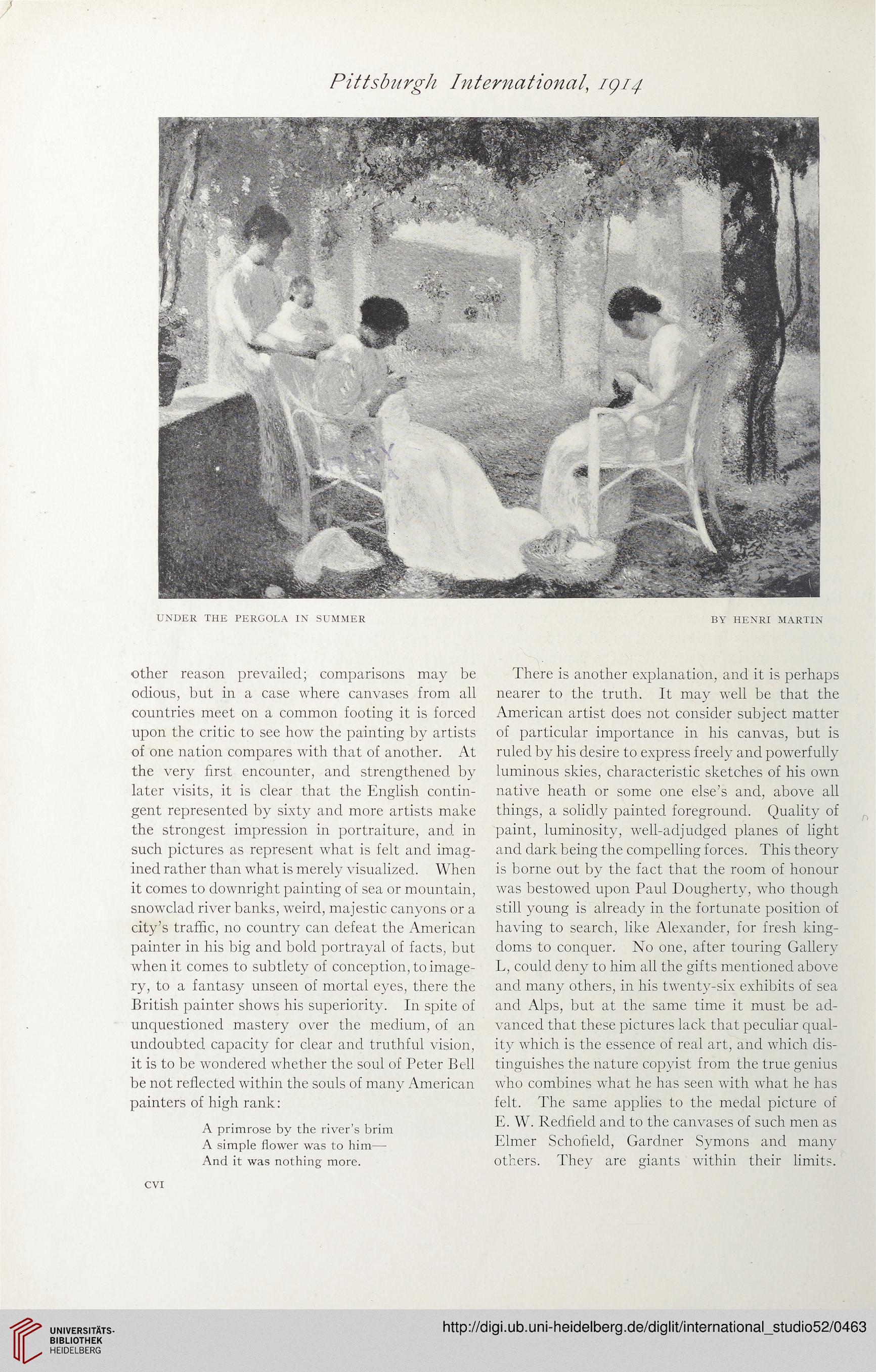Pittsburgh International, 1914
UNDER THE PERGOLA IN SUMMER
BY HENRI MARTIN
other reason prevailed; comparisons may be
odious, but in a case where canvases from all
countries meet on a common footing it is forced
upon the critic to see how the painting by artists
of one nation compares with that of another. At
the very first encounter, and strengthened by
later visits, it is clear that the English contin-
gent represented by sixty and more artists make
the strongest impression in portraiture, and in
such pictures as represent what is felt and imag-
ined rather than what is merely visualized. When
it comes to downright painting of sea or mountain,
snowclad river banks, weird, majestic canyons or a
city’s traffic, no country can defeat the American
painter in his big and bold portrayal of facts, but
when it comes to subtlety of conception, to image-
ry, to a fantasy unseen of mortal eyes, there the
British painter shows his superiority. In spite of
unquestioned mastery over the medium, of an
undoubted capacity for clear and truthful vision,
it is to be wondered whether the soul of Peter Bell
be not reflected within the souls of many American
painters of high rank:
A primrose by the river’s brim
A simple flower was to him—-
And it was nothing more.
There is another explanation, and it is perhaps
nearer to the truth. It may well be that the
American artist does not consider subject matter
of particular importance in his canvas, but is
ruled by his desire to express freely and powerfully
luminous skies, characteristic sketches of his own
native heath or some one else’s and, above all
things, a solidly painted foreground. Quality of
paint, luminosity, well-adjudged planes of light
and dark being the compelling forces. This theory
is borne out by the fact that the room of honour
was bestowed upon Paul Dougherty, who though
still young is already in the fortunate position of
having to search, like Alexander, for fresh king-
doms to conquer. No one, after touring Gallery
L, could deny to him all the gifts mentioned above
and many others, in his twenty-six exhibits of sea
and Alps, but at the same time it must be ad-
vanced that these pictures lack that peculiar qual-
ity which is the essence of real art, and which dis-
tinguishes the nature copyist from the true genius
who combines what he has seen with what he has
felt. The same applies to the medal picture of
E. W. Redfield and to the canvases of such men as
Elmer Schofield, Gardner Symons and many
others. They are giants within their limits.
cvi
UNDER THE PERGOLA IN SUMMER
BY HENRI MARTIN
other reason prevailed; comparisons may be
odious, but in a case where canvases from all
countries meet on a common footing it is forced
upon the critic to see how the painting by artists
of one nation compares with that of another. At
the very first encounter, and strengthened by
later visits, it is clear that the English contin-
gent represented by sixty and more artists make
the strongest impression in portraiture, and in
such pictures as represent what is felt and imag-
ined rather than what is merely visualized. When
it comes to downright painting of sea or mountain,
snowclad river banks, weird, majestic canyons or a
city’s traffic, no country can defeat the American
painter in his big and bold portrayal of facts, but
when it comes to subtlety of conception, to image-
ry, to a fantasy unseen of mortal eyes, there the
British painter shows his superiority. In spite of
unquestioned mastery over the medium, of an
undoubted capacity for clear and truthful vision,
it is to be wondered whether the soul of Peter Bell
be not reflected within the souls of many American
painters of high rank:
A primrose by the river’s brim
A simple flower was to him—-
And it was nothing more.
There is another explanation, and it is perhaps
nearer to the truth. It may well be that the
American artist does not consider subject matter
of particular importance in his canvas, but is
ruled by his desire to express freely and powerfully
luminous skies, characteristic sketches of his own
native heath or some one else’s and, above all
things, a solidly painted foreground. Quality of
paint, luminosity, well-adjudged planes of light
and dark being the compelling forces. This theory
is borne out by the fact that the room of honour
was bestowed upon Paul Dougherty, who though
still young is already in the fortunate position of
having to search, like Alexander, for fresh king-
doms to conquer. No one, after touring Gallery
L, could deny to him all the gifts mentioned above
and many others, in his twenty-six exhibits of sea
and Alps, but at the same time it must be ad-
vanced that these pictures lack that peculiar qual-
ity which is the essence of real art, and which dis-
tinguishes the nature copyist from the true genius
who combines what he has seen with what he has
felt. The same applies to the medal picture of
E. W. Redfield and to the canvases of such men as
Elmer Schofield, Gardner Symons and many
others. They are giants within their limits.
cvi




